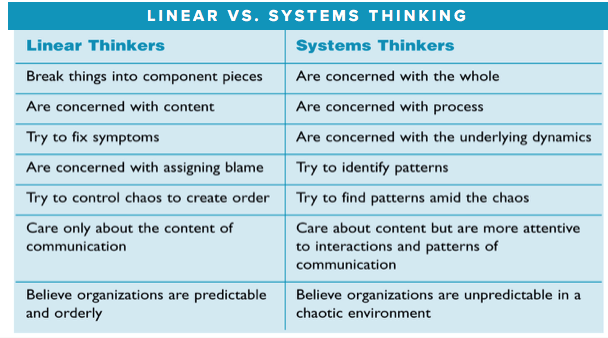What’s the best way to solve a business problem? Breaking it down into bite-sized chunks, or taking the 40,000-foot view of the situation? The former is what we might consider to be the traditional problem-solving approach – separating a problem into smaller components and analyzing the parts individually. However, more often than not – especially in the context of large organizations – this approach is linear and reductionist. Why? Because it ignores what are often crucial relationships between the problem being analyzed and its wider environment. This is linear thinking – A leads to B and results in C. But in truth, business problems rarely exist in such a neat, tidy and linear vacuum. The elements within the surrounding environment are connected, and through these connections they create a system. As such, in order to truly solve business problems – as opposed to simply treating individual symptoms – we need to take the helicopter view and begin thinking in systems. Systems thinking takes into consideration the surrounding system as a whole when dealing with a problem. By recognizing the dependencies within the system, systems thinking is able to effectively solve complex problems with many interrelated components.
Table of Contents
Toggle
(Image source: thesystemsthinker.com)
Problems never exist in isolation. They are surrounded by other problems – which themselves are surrounded by more problems still. The trouble – or, if you will, the problem – is that most of us have been taught from a very young age to take the linear approach to problem-solving. At school, we conduct science experiments that follow a linear path from problem to solution – aim, method, and outcome. We are disciplined and socialized to respond to reward (do all your homework and you’ll get good grades (and a treat from Mommy)) and punishment (don’t do it and you’ll fail your class (and be grounded for a week)). By the time we graduate and enter the working world, we have been effectively programmed to think in ordered, linear ways – so no wonder linear thinking is so dominant.
But business environments are not linear. They are chaotic, dynamic – nonlinear. And when problems emerge in nonlinear environments, they require nonlinear thinking to solve them. Systems thinking is a way of viewing the business environment as a complete system – a system that inherently relies upon a series of interconnected and interdependent parts. It seeks to oppose the linear and reductionist view – i.e. that a system or an organization can be understood by its individual and isolated parts – and replace it with the view that everything forms part of a larger whole, and that all parts are intrinsically connected and dependent upon one another. The reality is that A doesn’t always cause B which results in C. Sometimes C can cause A, while a combination of A and C can result in B – but it’s only by examining the system as a whole that we are able to see these complex relationships and thereby solve the complex business problems that result from them.
We’ve covered what systems thinking is and what it can be used for in our previous post ‘An Introduction to Systems Thinking’ – so please refer there for a slightly longer preamble on the basic concept of systems thinking. In this post, we want to take a deeper dive into systems theory as well as the wider vocabulary and tools of systems thinking. Let’s begin with the iceberg.
Systems Theory – The Systems Thinking Iceberg
Why is there such a tendency to view business problems as isolated events? Well, the short answer is because that’s the simplest way in which to view them. When a business problem emerges – say, when a defective product comes off the assembly line of a manufacturing company – leaders see the problem and move to fix it. The problem is an event, and our linear brains seek to find the cause, repair it, often assign blame, and then move on.
But what happens if that problem persists – if the event reoccurs numerous times? Now we might start to see a trend emerging – for example, a higher number of product defects during changes in shifts. This is what systems thinkers call a pattern – and when viewing patterns, we start to understand that events are rarely isolated and independent, but a consequence of something larger.
This “something larger” is a systemic structure – and systemic structures are responsible for generating the events and patterns we observe. If defective products are more common during shift changes, then the true business problem isn’t in fact the event or pattern of events itself, but something much more fundamental. Perhaps there’s a problem in the way shift changes are timed, or there’s no overlap between incoming and outgoing work crews, or there’s no communication system in place to facilitate the smooth hand-off of workloads between employees. The problem, we see, lies in the systemic structure – and the event, by contrast, is in fact just a symptom of the underlying problem.

(Image source: thesystemsthinker.com)
Together, events, patterns, and systemic structures form the systems thinking iceberg. But when we view business problems merely as isolated events, we’re only really looking at the tip of the iceberg. As Systems Thinker’s Daniel Kim points out: “A key thing to notice about the three different levels of perspective is that we live in an event-oriented world, and our language is rooted at the level of events. Indeed, we usually notice events much more easily than we notice patterns and systemic structures even though it is systems that are actually driving the events we do see. This tendency to only see events is consistent with our evolutionary history, which was geared toward responding to anything that posed an immediate danger to our well-being. […] It’s redesigning things at the systemic level that offers us far more leverage to shape our future than simply reacting to events does.”
Thinking in Loops
It is systems that generate patterns and events – this is fundamental to systems theory. But what does this really tell us about how systems behave, and what systems thinking tools are there to help us deepen our understanding about these behaviors?
Let’s begin with causal loop diagrams – also known as feedback loops. Taking a linear perspective, managers and leaders may view a series of events that continuously flow in one direction (A causes B causes C, etc.). Kim gives the example of sales going down (event A). The business takes action by launching a promotions campaign (event B), which leads to an increase in orders (event C), sales rising (event D), and a subsequent rise in backlogs (event E). But then sales start to fall again (event F), so the business responds with another promotional campaign (event G), and so on.
With linear thinking, even though events A and F – and B and G, and so on – are repeating events, they are viewed as separate and unrelated.

(Image source: thesystemsthinker.com)
However, from a feedback loop perspective, the systems thinker views each event not as discreet, but as connected to all other events in the system. The systems thinker, Kim says, constantly asks him/herself the question: “How do the consequences of my actions feed back to affect the system?” Linear thinking only allows us to draw connections between isolated cause-and-effect pairs – A and B, B and C, C and D, etc. – whereas with the feedback loop view we can see the interrelationships and interdependencies among all events. As Kim puts it: “The main problem with the linear view is that although it may be a technically accurate way of describing what happened when, it provides very little insight into how things happened and why. The primary purpose of the feedback view, on the other hand, is to gain a better understanding of all the forces that are producing the behaviors we are experiencing.”
Reinforcing Loops and Balancing Loops
There are two main types of feedback loops – reinforcing loops and balancing loops. Reinforcing loops are those where elements within a system reinforce or amplify more of the same. For example, a good product, leading to high sales, leading to more customers, leading to more word of mouth recommendations, leading to even more sales, even more satisfied customers, even more word of mouth, etc.

(Image source: threesigma.com)
Of course, reinforcing loops are just as likely to be negative as they are to be positive – a bad product will lead to poor sales, fewer customers, less word of mouth, even lower sales, even fewer customer, even less word of mouth, etc., etc., etc.
While reinforcing loops essentially destabilize systems – by compounding change in one direction – balancing loops, on the other hand, have the opposite effect. Balancing loops are the great stabilizers, resisting change in one direction by producing change in the opposite direction. They tend to materialize in organizations where control is needed. Take inventory control, for instance. The organization can’t afford to have too much capital tied up in large stockpiles of inventory – and so the goal is to have just enough product in the warehouse to fulfil existing orders. But, as the reinforcing loop takes hold and sales increase, production needs to be increased in kind until actual inventory comes as close as possible to the required inventory. At this point, corrective action needs to be taken to return balance to the system – and so production is once again slowed until more inventory is required. (Note that in the diagram below, arrows marked with an “s” indicate that as a variable changes, the next variable changes in the same direction – when marked with an “o”, the next variable changes in the opposite direction.)

(Image source: thesystemsthinker.com)
Managing balancing loops can be tricky – which is why systems thinking causal loop diagrams, though they appear simple, are vital for shedding some much-needed light on a situation. By understanding the structure of a balancing process and all the factors that affect it, it becomes possible to design appropriate strategies for effective action.

(Image source: thesystemsthinker.com)
Delays – Four Flavors
Another important though challenging element of systems thinking is found when we consider the inevitable delays that occur across every link within a complex system.
There are four types of delay that systems theory seeks to understand and account for – physical delays, transactional delays, informational delays, and delays in perception.
Physical delays are those that represent the amount of time it takes to move actual things from one place to another – such as products moving between warehouse and retailer, or converting raw materials into saleable products. Transactional delays represent the time it takes to complete a transaction – such as when negotiating a contract or simply making a sale over the phone. Informational delays relate to the time it takes to communicate information – about decisions that have been made or actions that have been taken. Finally, perceptional delays are slightly abstract, but represent the delays in perception about the changes that have actually been made – for example, if product improvements have been made, there will tend to be a delay before customers or even employees perceive of the changes, and thereby adjust their overall perceptions of the brand.
Delays – be they physical, transactional, informational, or perceptional – must be factored in when creating balancing loops. This is fundamental to systems thinking. Consider a typical production setting, for example. When creating a balancing loop to keep a favorable balance between production and inventory, if there is ever a backlog, so long as there are no significant delays within the system, increasing production would lead to higher shipments and thereby reduce the backlog. However, this scenario is more akin to a reinforcing loop as all variables are changing the next variable in the same direction.
What’s more likely to be encountered is some sort of delay. Let’s say the factory is already working at maximum capacity. As such, as the backlog emerges, there will be a delay before production capacity can be increased to deal with it – and the backlog will continue to grow in the meantime, causing yet more delays.

(Image source: thesystemsthinker.com)
But of course, with systems thinking, we can never make the mistake of thinking that any one loop – be it balancing or reinforcing – exists in isolation. Continuing with the same example, the delay in loop B1 above will likely have an impact on the wider business, as the delay in facilitating more production will affect customer order fulfillment. This, in turn, may lead to a decrease in service quality, which may affect future business. During the delay in which the manufacturer attempts to increase production to clear the backlog, customers may take their business elsewhere. Now, though production has increased, fewer orders are coming in – a new delay to contend with (see B2 below), which must be factored into the balancing loop, or, in this case, the “coupled loop”. As production is able to more quickly work through backlogs, the factory can ship products faster than its competitors, leading to a revival of new orders. However, what comes next, of course, is another surge in backlogs – and so the cycle repeats again.

(Image source: thesystemsthinker.com)
Identifying all possible types of delays is essential to creating meaningful balancing loops – and importantly for systems thinking, will help you determine the delays that may be affecting or likely to affect other processes. In systems theory, this is crucial for gaining insight and understanding into your system’s – and subsystems’ – behavior.
Final Thoughts
Systems thinking is an incredibly broad and detailed discipline – and an incredibly valuable one at that. Understanding the organization in terms of a system with many interrelated and interdependent parts allows leaders to expand the range of choices available for solving business problems, and indeed enables them to start unearthing the systemic causes of those problems rather than erroneously viewing each one as an isolated and independent event.
But the power of systems thinking goes beyond problem-solving. Using reinforcement loops and balancing loops with delays not only helps organizations surface issues that may be affecting productivity and profitability, but also design new systems that generate the kinds of events and patterns that they want. However, what leaders must understand when it comes to systems thinking is that there are no perfect solutions. Why? For the simple reason that, when dealing with systems, all choices made have an impact on other parts of the system. Nonetheless, using systems thinking tools, leaders can anticipate each impact, and thereby either minimize its severity or leverage it to the organization’s advantage. In this way, what systems thinking does is allow the business to make better informed choices.
Systems thinking is indeed the antidote to the “quick fix” mindset. It is a means of seeing the complexity of an organization and recognizing that the majority of the time resorting to quick fixes is no way to succeed. As the business world becomes ever more tightly interwoven globally – and technology makes ever more connections possible – systems thinking is emerging as one of the key management competencies of the modern age. Leaders and managers working today need to start learning how to leave linear thinking behind, and instead adopt the big-picture approach to tackling business problems.
What is Systems Thinking?
Systems thinking takes into consideration the surrounding system as a whole when dealing with a problem. By recognizing the dependencies within the system, systems thinking is able to effectively solve complex problems with many interrelated components. Problems never exist in isolation. They are surrounded by other problems – which themselves are surrounded by more problems still. When we graduate and enter the working world, we have been effectively programmed to think in ordered, linear ways. But business environments are not linear. They are chaotic, dynamic – nonlinear. And when problems emerge in nonlinear environments, they require nonlinear thinking to solve them. Systems thinking is a way of viewing the business environment as a complete system – a system that inherently relies upon a series of interconnected and interdependent parts.





